
English garden
Encyclopedia
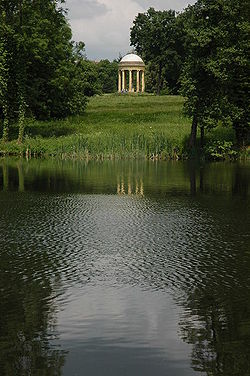
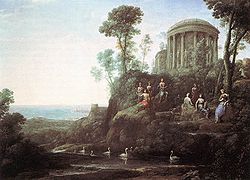
Landscape garden
The term landscape garden is often used to describe the English garden design style characteristic of the eighteenth century, that swept the Continent replacing the formal Renaissance garden and Garden à la française models. The work of Lancelot 'Capability' Brown is particularly influential.The...
which emerged in England in the early 18th century, and spread across Europe, replacing the more formal, symmetrical Garden à la française
Garden à la française
The French formal garden, also called jardin à la française, is a style of garden based on symmetry and the principle of imposing order over nature. It reached its apogee in the 17th century with the creation of the Gardens of Versailles, designed for Louis XIV by the landscape architect André Le...
of the 17th century as the principal gardening style of Europe. The English garden presented an idealized view of nature. They were often inspired by paintings of landscapes by Claude Lorraine and Nicolas Poussin
Nicolas Poussin
Nicolas Poussin was a French painter in the classical style. His work predominantly features clarity, logic, and order, and favors line over color. His work serves as an alternative to the dominant Baroque style of the 17th century...
, and some were Influenced by the classic Chinese gardens of the East, which had recently been described by European travelers. The English garden usually included a lake, sweeps of gently rolling lawns set against groves of trees, and recreations of classical temples, Gothic ruins, bridges, and other picturesque architecture, designed to recreate an idyllic pastoral landscape. By the end of the 18th century the English garden was being imitated by the French landscape garden
French landscape garden
The French landscape garden is a style of garden inspired by idealized Italian landscapes and the romantic paintings of Hubert Robert, Claude Lorrain and Nicolas Poussin, European ideas about Chinese gardens, and the philosophy of Jean-Jacques Rousseau...
, and as far away as St. Petersburg, Russia, in Pavlovsk, the gardens of the future Emperor Paul. It also had a major influence on the form of the public parks and gardens which appeared around the world in the 19th century.
History of the English Landscape Garden

John Vanbrugh
Sir John Vanbrugh – 26 March 1726) was an English architect and dramatist, perhaps best known as the designer of Blenheim Palace and Castle Howard. He wrote two argumentative and outspoken Restoration comedies, The Relapse and The Provoked Wife , which have become enduring stage favourites...
(1664–1726) and Nicholas Hawksmoor
Nicholas Hawksmoor
Nicholas Hawksmoor was a British architect born in Nottinghamshire, probably in East Drayton.-Life:Hawksmoor was born in Nottinghamshire in 1661, into a yeoman farming family, almost certainly in East Drayton, Nottinghamshire. On his death he was to leave property at nearby Ragnall, Dunham and a...
at Castle Howard
Castle Howard
Castle Howard is a stately home in North Yorkshire, England, north of York. One of the grandest private residences in Britain, most of it was built between 1699 and 1712 for the 3rd Earl of Carlisle, to a design by Sir John Vanbrugh...
(1699–1712); Blenheim Palace
Blenheim Palace
Blenheim Palace is a monumental country house situated in Woodstock, Oxfordshire, England, residence of the dukes of Marlborough. It is the only non-royal non-episcopal country house in England to hold the title of palace. The palace, one of England's largest houses, was built between...
(1705–1722), Castle Howard
Castle Howard
Castle Howard is a stately home in North Yorkshire, England, north of York. One of the grandest private residences in Britain, most of it was built between 1699 and 1712 for the 3rd Earl of Carlisle, to a design by Sir John Vanbrugh...
, and the Claremont Landscape Garden
Claremont Landscape Garden
Claremont Landscape Garden, just outside Esher, Surrey, England, is one of the earliest surviving gardens of its kind of landscape design, the English Landscape Garden — still featuring its original 18th century layout...
at Claremont House (1715–1727). These parks featured vast lawns, woods, and pieces of architecture, such as the classical mausoleum designed by Hawksmoor at Castle Howard. At the center of the composition was the house, behind which were formal and symmetrical gardens in the style of the Garden à la française
Garden à la française
The French formal garden, also called jardin à la française, is a style of garden based on symmetry and the principle of imposing order over nature. It reached its apogee in the 17th century with the creation of the Gardens of Versailles, designed for Louis XIV by the landscape architect André Le...
, with ornate carpets of floral designs and walls of hedges, decorated with statues and fountains. These gardens, modelled after the gardens of Versailles
Gardens of Versailles
The Gardens of Versailles occupy part of what was once the Domaine royal de Versailles, the royal demesne of the château of Versailles. Situated to the west of the palace, the gardens cover some 800 hectares of land, much of which is landscaped in the classic French Garden style perfected here by...
, were designed to impress visitors with their size and grandeur.
William Kent and Charles Bridgeman
The new style that became known as the English garden was invented by landscape designers William KentWilliam Kent
William Kent , born in Bridlington, Yorkshire, was an eminent English architect, landscape architect and furniture designer of the early 18th century.He was baptised as William Cant.-Education:...
and Charles Bridgeman
Charles Bridgeman
Charles Bridgeman was an English garden designer in the onset of the naturalistic landscape style. Although he was a key figure in the transition of English garden design from the Anglo-Dutch formality of patterned parterres and avenues to a freer style that incorporated formal, structural and...
, working for wealthy patrons, including Richard Temple, 1st Viscount Cobham
Richard Temple, 1st Viscount Cobham
Field Marshal Richard Temple, 1st Viscount Cobham PC was a British soldier and Whig politician. He was known for his ownership of and modifications to the estate at Stowe and for serving as a political mentor to the young William Pitt.-Early life:Temple was the son of Sir Richard Temple, 3rd...
, Richard Boyle, 3rd Earl of Burlington
Richard Boyle, 3rd Earl of Burlington
Richard Boyle, 3rd Earl of Burlington and 4th Earl of Cork PC , born in Yorkshire, England, was the son of Charles Boyle, 2nd Earl of Burlington and 3rd Earl of Cork...
, and banker Henry Hoare
Henry Hoare
Henry Hoare II , known as Henry the Magnificent, was an English banker and garden owner-designer.-Career:Born the son of Henry Hoare I and educated at Westminster School, Henry Hoare dominated the Hoare family through his wealth and personal charisma. Henry was a partner for nearly 60 years in C...
; men who had large country estates, were members of the anti-royalist Whig Party, had classical educations, were patrons of the arts, and had taken the Grand tour to Italy, where they had seen the Roman ruins and Italian landscapes they reproduced in their gardens.
William Kent (1685–1738) was an architect, painter and furniture designer who introduced Palladian style architecture to England. Kent's inspiration came from Palladio's buildings in the Veneto
Veneto
Veneto is one of the 20 regions of Italy. Its population is about 5 million, ranking 5th in Italy.Veneto had been for more than a millennium an independent state, the Republic of Venice, until it was eventually annexed by Italy in 1866 after brief Austrian and French rule...
and the landscapes and ruins around Rome - he lived in Italy from 1709 to 1719, and brought back many drawings of antique architecture and landscapes. His gardens were designed to compliment the Palladian archicture of the houses he built.
Charles Bridgeman (1690–1738) was the son of a gardener and an experienced horticulturist, who became the Royal Gardener for Queen Anne
Anne of Great Britain
Anne ascended the thrones of England, Scotland and Ireland on 8 March 1702. On 1 May 1707, under the Act of Union, two of her realms, England and Scotland, were united as a single sovereign state, the Kingdom of Great Britain.Anne's Catholic father, James II and VII, was deposed during the...
and Prince George of Denmark, responsible for tending and redesigning the royal gardens at Windsor
Windsor, Berkshire
Windsor is an affluent suburban town and unparished area in the Royal Borough of Windsor and Maidenhead in Berkshire, England. It is widely known as the site of Windsor Castle, one of the official residences of the British Royal Family....
, Kensington Palace
Kensington Palace
Kensington Palace is a royal residence set in Kensington Gardens in the Royal Borough of Kensington and Chelsea in London, England. It has been a residence of the British Royal Family since the 17th century and is the official London residence of the Duke and Duchess of Cambridge, the Duke and...
http://www.gardenvisit.com/g/kens1.htm, Hampton Court, St. James's Park
St. James's Park
St. James's Park is a 23 hectare park in the City of Westminster, central London - the oldest of the Royal Parks of London. The park lies at the southernmost tip of the St. James's area, which was named after a leper hospital dedicated to St. James the Less.- Geographical location :St. James's...
and Hyde Park
Hyde Park, London
Hyde Park is one of the largest parks in central London, United Kingdom, and one of the Royal Parks of London, famous for its Speakers' Corner.The park is divided in two by the Serpentine...
. He collaborated with Kent on several major gardens, providing the botanical expertise which allowed Kent to realize his architectural visions.
Chiswick House
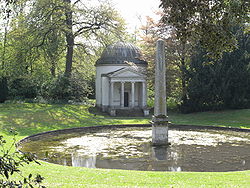
Chiswick House
Chiswick House is a Palladian villa in Burlington Lane, Chiswick, in the London Borough of Hounslow in England. Set in , the house was completed in 1729 during the reign of George II and designed by Lord Burlington. William Kent , who took a leading role in designing the gardens, created one of the...
for Richard Boyle, 3rd Earl of Burlington
Richard Boyle, 3rd Earl of Burlington
Richard Boyle, 3rd Earl of Burlington and 4th Earl of Cork PC , born in Yorkshire, England, was the son of Charles Boyle, 2nd Earl of Burlington and 3rd Earl of Cork...
. The first gardens that he laid out between 1724 and 1733 had many formal elements of a Garden à la française
Garden à la française
The French formal garden, also called jardin à la française, is a style of garden based on symmetry and the principle of imposing order over nature. It reached its apogee in the 17th century with the creation of the Gardens of Versailles, designed for Louis XIV by the landscape architect André Le...
, including alleys forming a trident and canals, but they had something new - pictureque recreation of an Ionic temple set in a theater of trees. Between 1733 and 1736, he redesigned the garden again, adding lawns sloping down to the edge of river, and a small cascade. For the first time the form of a garden was inspired not by architecture, but by an idealized version of nature.
Rousham

Rousham House
Rousham House is a Jacobean country house at Rousham in Oxfordshire, England. The house has been in the ownership of one family since it was built.-History:...
in Oxfordshire is considered by some as the most accomplished and significant of William Kent's work. The patron was General Dormer, who commissioned Bridgeman to begin the garden in 1727, then brought in Kent to recreate it in 1737. Bridgeman had built a series of gardens, including a grotto of Venus, on the slope along the river Cherwell, connected by a straight alleys. Kent turned the alleys into winding paths, built a gently turning stream, used the natural landscape features and slopes, and created a series of views and tableaus decorated with allegorical statues of Apollo, a wounded gladiator, a lion attacking a horse, and other subjects. He placed "eye-catchers," pieces of classical architecture, to decorate the landscape, and he made use of the "ha-ha," a trench used to hide fences so the garden seemed to go into the far distance. Finally, he added cascades modelled on those of the garden of Aldobrandini
Aldobrandini
The Aldobrandini are an Italian noble family from Florence, with close ties to the Vatican. Its Roman fortunes were made when Ippolito Aldobrandini became pope under the name Pope Clement VIII. He arranged the marriage that linked the Aldobrandini with the Roman family of Pamphili...
and Pratolino in Italy, to add movement and drama.
Stowe House
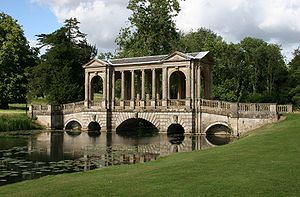

Stowe House
Stowe House is a Grade I listed country house located in Stowe, Buckinghamshire, England. It is the home of Stowe School, an independent school. The gardens , a significant example of the English Landscape Garden style, along with part of the Park, passed into the ownership of The National Trust...
, in Buckinghamshire
Buckinghamshire
Buckinghamshire is a ceremonial and non-metropolitan home county in South East England. The county town is Aylesbury, the largest town in the ceremonial county is Milton Keynes and largest town in the non-metropolitan county is High Wycombe....
, (1730–1738), was an even more radical departure from the formal French garden. In the early 18th century, Richard Temple, 1st Viscount Cobham
Richard Temple, 1st Viscount Cobham
Field Marshal Richard Temple, 1st Viscount Cobham PC was a British soldier and Whig politician. He was known for his ownership of and modifications to the estate at Stowe and for serving as a political mentor to the young William Pitt.-Early life:Temple was the son of Sir Richard Temple, 3rd...
, had commissioned Charles Bridgeman to design a formal garden, with architectural decorations by John Vanbrugh
John Vanbrugh
Sir John Vanbrugh – 26 March 1726) was an English architect and dramatist, perhaps best known as the designer of Blenheim Palace and Castle Howard. He wrote two argumentative and outspoken Restoration comedies, The Relapse and The Provoked Wife , which have become enduring stage favourites...
. Bridgeman's design included an octagonal lake and a Rotondo (1720–21) designed by Vanbrugh.
In the 1730s, William Kent
William Kent
William Kent , born in Bridlington, Yorkshire, was an eminent English architect, landscape architect and furniture designer of the early 18th century.He was baptised as William Cant.-Education:...
and James Gibbs
James Gibbs
James Gibbs was one of Britain's most influential architects. Born in Scotland, he trained as an architect in Rome, and practised mainly in England...
were appointed to work with Bridgeman, who died in 1738. Kent remade the lake in a more natural shape, and created a new kind of garden, which took visitors on a tour of picturesque landscapes. It eventually included a Palladian bridge (1738); a Temple of Venus (1731), in the form of a Palladian villa; A Temple of Ancient Virtues (1737), with statues of famous Greeks and Romans; a Temple of British Worthies (1734–1735), with statues of British heroes; and a Temple of Modern Virtues, which was deliberately left in ruins, which contained a headless statue of Robert Walpole
Robert Walpole
Robert Walpole, 1st Earl of Orford, KG, KB, PC , known before 1742 as Sir Robert Walpole, was a British statesman who is generally regarded as having been the first Prime Minister of Great Britain....
, Cobham's political rival.
The garden attracted visitors from all over Europe, including Jean-Jacques Rousseau
Jean-Jacques Rousseau
Jean-Jacques Rousseau was a Genevan philosopher, writer, and composer of 18th-century Romanticism. His political philosophy influenced the French Revolution as well as the overall development of modern political, sociological and educational thought.His novel Émile: or, On Education is a treatise...
. It became the inspiration for landscape gardens in Britain and on the Continent. (See French landscape garden
French landscape garden
The French landscape garden is a style of garden inspired by idealized Italian landscapes and the romantic paintings of Hubert Robert, Claude Lorrain and Nicolas Poussin, European ideas about Chinese gardens, and the philosophy of Jean-Jacques Rousseau...
.)
Stourhead

Stourhead
Stourhead is a 2,650 acre estate at the source of the River Stour near Mere, Wiltshire, England. The estate includes a Palladian mansion, the village of Stourton, gardens, farmland, and woodland...
, in Wiltshire
Wiltshire
Wiltshire is a ceremonial county in South West England. It is landlocked and borders the counties of Dorset, Somerset, Hampshire, Gloucestershire, Oxfordshire and Berkshire. It contains the unitary authority of Swindon and covers...
(1741–80), created by banker Henry Hoare
Henry Hoare
Henry Hoare II , known as Henry the Magnificent, was an English banker and garden owner-designer.-Career:Born the son of Henry Hoare I and educated at Westminster School, Henry Hoare dominated the Hoare family through his wealth and personal charisma. Henry was a partner for nearly 60 years in C...
, was one of first 'picturesque' gardens, inspired to resemble the paintings of Claude Lorrain. Hoare had traveled to Italy on the Grand Tour
Grand Tour
The Grand Tour was the traditional trip of Europe undertaken by mainly upper-class European young men of means. The custom flourished from about 1660 until the advent of large-scale rail transit in the 1840s, and was associated with a standard itinerary. It served as an educational rite of passage...
and had returned with a painting by Claude Lorrain. Hoare dammed a stream on his estate, created a lake, and surrounded the lake with landscapes and architectural constructions representing the different steps of the journey of Aeneas in the Aeneid
Aeneid
The Aeneid is a Latin epic poem, written by Virgil between 29 and 19 BC, that tells the legendary story of Aeneas, a Trojan who travelled to Italy, where he became the ancestor of the Romans. It is composed of roughly 10,000 lines in dactylic hexameter...
by Virgil
Virgil
Publius Vergilius Maro, usually called Virgil or Vergil in English , was an ancient Roman poet of the Augustan period. He is known for three major works of Latin literature, the Eclogues , the Georgics, and the epic Aeneid...
.
The Great Age of the English Garden - Capability Brown
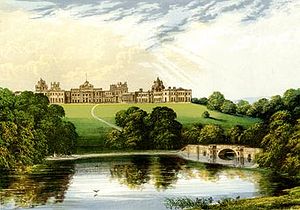

Charles Bridgeman
Charles Bridgeman was an English garden designer in the onset of the naturalistic landscape style. Although he was a key figure in the transition of English garden design from the Anglo-Dutch formality of patterned parterres and avenues to a freer style that incorporated formal, structural and...
, then succeeded William Kent in 1748.
Brown's contribution was to simplify the garden by eliminating geometric structures, alleys, and parterres near the house and replacing them with rolling lawns and extensive views out to isolated groups of trees, making the landscape seem even larger. "He sought to create an ideal landscape out of the English countryside." He created artificial lakes and used dams and canals to transform streams or springs into the illusion that a river flowed through the garden.
He compared his own role as a garden designer to that of a poet or composer. "Here I put a comma, there, when it's necessary to cut the view, I put a parenthesis; there I end it with a period and start on another theme."
Brown designed 170 gardens. The most important were:
- PetworthPetworth HousePetworth House in Petworth, West Sussex, England, is a late 17th-century mansion, rebuilt in 1688 by Charles Seymour, 6th Duke of Somerset, and altered in the 1870s by Anthony Salvin...
(West SussexWest SussexWest Sussex is a county in the south of England, bordering onto East Sussex , Hampshire and Surrey. The county of Sussex has been divided into East and West since the 12th century, and obtained separate county councils in 1888, but it remained a single ceremonial county until 1974 and the coming...
) in 1752; - Chatsworth (DerbyshireDerbyshireDerbyshire is a county in the East Midlands of England. A substantial portion of the Peak District National Park lies within Derbyshire. The northern part of Derbyshire overlaps with the Pennines, a famous chain of hills and mountains. The county contains within its boundary of approx...
) in 1761; - Bowood (WiltshireWiltshireWiltshire is a ceremonial county in South West England. It is landlocked and borders the counties of Dorset, Somerset, Hampshire, Gloucestershire, Oxfordshire and Berkshire. It contains the unitary authority of Swindon and covers...
) in 1763; - Blenheim Palace (OxfordshireOxfordshireOxfordshire is a county in the South East region of England, bordering on Warwickshire and Northamptonshire , Buckinghamshire , Berkshire , Wiltshire and Gloucestershire ....
) in 1764.
The Anglo-Chinese Garden
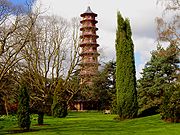
Joseph Addison
Joseph Addison was an English essayist, poet, playwright and politician. He was a man of letters, eldest son of Lancelot Addison...
in an essay in 1712, who used them to attack the English gardeners who, instead of imitating nature, tried to make their gardens in the French style, as far from nature as possible.
The novelty and exoticism of Chinese art and architecture in Europe led in 1738 to the construction of the first Chinese house in an English garden, in the garden of Stowe House
Stowe House
Stowe House is a Grade I listed country house located in Stowe, Buckinghamshire, England. It is the home of Stowe School, an independent school. The gardens , a significant example of the English Landscape Garden style, along with part of the Park, passed into the ownership of The National Trust...
. The style became even more popular thanks to William Chambers
William Chambers (architect)
Sir William Chambers was a Scottish architect, born in Gothenburg, Sweden, where his father was a merchant. Between 1740 and 1749 he was employed by the Swedish East India Company making several voyages to China where he studied Chinese architecture and decoration.Returning to Europe, he studied...
(1723–1796), who lived in China from 1745 to 1747, and wrote a book, The Drawings, buildings, furniture, habits, machines and untensils of the Chinese, published in 1757. In 1761 he built a Chinese pagoda, house and garden in Kew, London, as part of Kew Gardens, a park with gardens and architecture symbolizing all parts of the world and all architectural styles. Thereafter Chinese pagodas began to appear in other English gardens, then in France and elsewhere on the continent. French and other European observers coined the term Jardin Anglo-Chinois (Anglo-Chinese garden) for this style of garden.
The Gothic Revival Influence on English Gardens
In the 1750s, classical architecture and Chinese architecture were joined by gothic revival ruins in English gardens. This was largely the result of poet Horace Walpole, who introduced gothic revival features into his house and garden at Strawberry HillStrawberry Hill House
Strawberry Hill is the Gothic Revival villa of Horace Walpole which he built in the second half of the 18th century in what is now an affluent area of the London Borough of Richmond upon Thames in Twickenham, London...
in Twickenham
Twickenham
Twickenham is a large suburban town southwest of central London. It is the administrative headquarters of the London Borough of Richmond upon Thames and one of the locally important district centres identified in the London Plan...
.
At Stowe, Capability Brown followed the new fashion between 1740 and 1753 by adding a new section to the park, called Hawkwelle Hill or the gothic promenade, with a gothic revival building.
The English Garden Spreads to the Continent
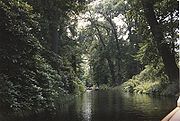
Thomas Whately
Thomas Whately , an English politician and writer, was a Member of Parliament , who served as Commissioner on the Board of Trade, as Secretary to the Treasury under Lord Grenville, and as Under- secretary of State under Lord North . As an M.P...
and published in London in 1770, was translated into French in 1771. After the end of the Seven Years War
Seven Years' War
The Seven Years' War was a global military war between 1756 and 1763, involving most of the great powers of the time and affecting Europe, North America, Central America, the West African coast, India, and the Philippines...
in 1763, French noblemen were able to voyage to England and see the gardens for themselves, and the style began to be adapted in French gardens. The new style also had the advantage of requiring fewer gardeners, and was easier to maintain, than the French garden.
One of the first English gardens on the continent was at Ermenonville
Ermenonville
Ermenonville is a small village in northern France. It is designated municipally as a commune within the département of Oise.Ermenonville is notable for its park named for Jean-Jacques Rousseau by René Louis de Girardin...
, in France, built by marquis René Louis de Girardin
René Louis de Girardin
René Louis de Girardin , Marquis of Vauvray, was Jean-Jacques Rousseau's last pupil. He created the first French landscape garden at Ermenonville. It was inspired by Rousseau's ideas...
from 1763 to 1776 and based on the ideals of Jean Jacques Rousseau, who was buried within the park. Rousseau and the garden's founder had visited Stowe a few years earlier. Other early examples were the Désert de Retz
Désert de Retz
The Désert de Retz is an Anglo-Chinois or French landscape garden - created on the edge of the forêt de Marly in the commune of Chambourcy, in north-central France. It was built at the end of the 18th century by the aristocrat François Racine de Monville on his estate...
, Yvelines (1774–1782); the Gardens of the Château de Bagatelle
Château de Bagatelle
The Château de Bagatelle is a small neoclassical château with a French landscape garden in the Bois de Boulogne in the XVIe arrondissement of Paris...
, in the Bois de Boulogne
Bois de Boulogne
The Bois de Boulogne is a park located along the western edge of the 16th arrondissement of Paris, near the suburb of Boulogne-Billancourt and Neuilly-sur-Seine...
, west of Paris (1777–1784);
The Folie Saint James
Folie Saint James
The Folie St. James was a French landscape garden created between 1777 and 1780 in the Paris suburb of Neuilly by Claude Baudard de Saint James, the treasurer of the French Navy under Louis XVI of France. It was the work of landscape architect François-Joseph Bélanger, who had designed the garden...
, in Neuilly-sur-Seine
Neuilly-sur-Seine
Neuilly-sur-Seine is a commune in the western suburbs of Paris, France. It is located from the center of Paris.Although Neuilly is technically a suburb of Paris, it is immediately adjacent to the city and directly extends it. The area is composed of mostly wealthy, select residential...
, (1777–1780); and the Château de Méréville
Château de Méréville
The Château de Méréville is a chateau in Méréville in the valley of the Juine, France. It is the rival of the Désert de Retz as two of the most extensive Landscape Gardens provided with follies and picturesque features — parcs à fabriques — made in the late eighteenth century...
, in the Essonne
Essonne
Essonne is a French department in the region of Île-de-France. It is named after the Essonne River.It was formed on 1 January 1968 when Seine-et-Oise was split into smaller departments.- History :...
department, (1784–1786). Even at Versailles, the home of the most classical of all French gardens, a small English landscape park with a roman temple was built by the Petit Trianon
Petit Trianon
The Petit Trianon is a small château located on the grounds of the Palace of Versailles in Versailles, France.-Design and construction:...
and a mock village, the Hameau de la reine, Versailles (1783–1789), was created for Marie Antoinette
Marie Antoinette
Marie Antoinette ; 2 November 1755 – 16 October 1793) was an Archduchess of Austria and the Queen of France and of Navarre. She was the fifteenth and penultimate child of Holy Roman Empress Maria Theresa and Holy Roman Emperor Francis I....
. (See the French landscape garden
French landscape garden
The French landscape garden is a style of garden inspired by idealized Italian landscapes and the romantic paintings of Hubert Robert, Claude Lorrain and Nicolas Poussin, European ideas about Chinese gardens, and the philosophy of Jean-Jacques Rousseau...
).
The new style also spread to Germany. The central Wörlitzer Park, adjacent to the small town of Wörlitz
Wörlitz
' is a town and a former municipality in the district of Wittenberg, in Saxony-Anhalt, Germany. Since 1 January 2011, it is part of the town Oranienbaum-Wörlitz. It is situated on the left bank of the Elbe, east of Dessau...
, was laid out between 1769 and 1773 by the Duke Leopold III, based on the models of Claremont
Claremont Landscape Garden
Claremont Landscape Garden, just outside Esher, Surrey, England, is one of the earliest surviving gardens of its kind of landscape design, the English Landscape Garden — still featuring its original 18th century layout...
, Stourhead and Stowe Landscape Garden
Stowe House
Stowe House is a Grade I listed country house located in Stowe, Buckinghamshire, England. It is the home of Stowe School, an independent school. The gardens , a significant example of the English Landscape Garden style, along with part of the Park, passed into the ownership of The National Trust...
. Another notable example was The Englischer Garten in Munich
Munich
Munich The city's motto is "" . Before 2006, it was "Weltstadt mit Herz" . Its native name, , is derived from the Old High German Munichen, meaning "by the monks' place". The city's name derives from the monks of the Benedictine order who founded the city; hence the monk depicted on the city's coat...
, Germany
Germany
Germany , officially the Federal Republic of Germany , is a federal parliamentary republic in Europe. The country consists of 16 states while the capital and largest city is Berlin. Germany covers an area of 357,021 km2 and has a largely temperate seasonal climate...
, created in 1789 by Sir Benjamin Thompson
Benjamin Thompson
Sir Benjamin Thompson, Count Rumford , FRS was an American-born British physicist and inventor whose challenges to established physical theory were part of the 19th century revolution in thermodynamics. He also served as a Lieutenant-Colonel in the Loyalist forces in America during the American...
(1753–1814).
The style also spread rapidly to Russia, where in 1774 Catherine the Great adapted the new style in the park of her palace at Tsarskoe Selo, complete with a mock Chinese village and a Palladian bridge, modelled after that at Wilton House
Wilton House
Wilton House is an English country house situated at Wilton near Salisbury in Wiltshire. It has been the country seat of the Earls of Pembroke for over 400 years....
.
Characteristics of the English Garden
The Continental European "English garden" is characteristically on a smaller scale and more filled with "eye-catchers" than most English landscape gardens: grottoes, temples, tea-houses, belvederes, pavilions, sham ruins, bridges and statues, though the main ingredients of the landscape gardens in England are sweeps of gently rolling ground and water, against a woodland background with clumps of trees and outlier groves. The name— not used in the United KingdomUnited Kingdom
The United Kingdom of Great Britain and Northern IrelandIn the United Kingdom and Dependencies, other languages have been officially recognised as legitimate autochthonous languages under the European Charter for Regional or Minority Languages...
, where "landscape garden
Landscape garden
The term landscape garden is often used to describe the English garden design style characteristic of the eighteenth century, that swept the Continent replacing the formal Renaissance garden and Garden à la française models. The work of Lancelot 'Capability' Brown is particularly influential.The...
" serves— differentiates it from the formal baroque
Baroque
The Baroque is a period and the style that used exaggerated motion and clear, easily interpreted detail to produce drama, tension, exuberance, and grandeur in sculpture, painting, literature, dance, and music...
design of the Garden à la française
Garden à la française
The French formal garden, also called jardin à la française, is a style of garden based on symmetry and the principle of imposing order over nature. It reached its apogee in the 17th century with the creation of the Gardens of Versailles, designed for Louis XIV by the landscape architect André Le...
. One of the best-known English gardens in Europe is the Englischer Garten in Munich
Munich
Munich The city's motto is "" . Before 2006, it was "Weltstadt mit Herz" . Its native name, , is derived from the Old High German Munichen, meaning "by the monks' place". The city's name derives from the monks of the Benedictine order who founded the city; hence the monk depicted on the city's coat...
.
The dominant style was revised in the early 19th century to include more "gardenesque
Gardenesque
The term gardenesque was introduced by John Claudius Loudon to describe a style of planting design in accordance with his 'Principle of Recognition'.-Definitions:...
" features, including shrubberies
Shrubbery
A shrubbery is a wide border to a garden where shrubs are thickly planted; or a similar larger area with a path winding through it. A shrubbery was a feature of 19th-century gardens in the English manner, with its origins in the gardenesque style of the early part of the century...
with gravelled walks, tree plantations to satisfy botanical curiosity, and, most notably, the return of flowers, in skirts of sweeping planted beds. This is the version of the landscape garden most imitated in Europe in the 19th century. The outer areas of the "home park" of English country house
English country house
The English country house is a large house or mansion in the English countryside. Such houses were often owned by individuals who also owned a London house. This allowed to them to spend time in the country and in the city—hence, for these people, the term distinguished between town and country...
s retain their naturalistic shaping. English gardening since the 1840s has been on a more restricted scale, closer and more allied to the residence.
The canonical European English park contains a number of Romantic elements. Always present is a pond
Pond
A pond is a body of standing water, either natural or man-made, that is usually smaller than a lake. A wide variety of man-made bodies of water are classified as ponds, including water gardens, water features and koi ponds; all designed for aesthetic ornamentation as landscape or architectural...
or small lake with a pier
Pier
A pier is a raised structure, including bridge and building supports and walkways, over water, typically supported by widely spread piles or pillars...
or bridge
Bridge
A bridge is a structure built to span physical obstacles such as a body of water, valley, or road, for the purpose of providing passage over the obstacle...
. Overlooking the pond is a round or hexagonal pavilion
Pavilion (structure)
In architecture a pavilion has two main meanings.-Free-standing structure:Pavilion may refer to a free-standing structure sited a short distance from a main residence, whose architecture makes it an object of pleasure. Large or small, there is usually a connection with relaxation and pleasure in...
, often in the shape of a monopteros
Monopteros
A monopteros is a circular colonnade supporting a roof but without any walls. Unlike a tholos , it does not have a cella. In Greek and especially Roman antiquity the term could also be used for a tholos...
, a Roman temple. Sometimes the park also has a "Chinese" pavilion
Chinoiserie
Chinoiserie, a French term, signifying "Chinese-esque", and pronounced ) refers to a recurring theme in European artistic styles since the seventeenth century, which reflect Chinese artistic influences...
. Other elements include a grotto
Grotto
A grotto is any type of natural or artificial cave that is associated with modern, historic or prehistoric use by humans. When it is not an artificial garden feature, a grotto is often a small cave near water and often flooded or liable to flood at high tide...
and imitation ruins.
Notable designers of the English prototypes of the Englischer Garten include John Vanbrugh
John Vanbrugh
Sir John Vanbrugh – 26 March 1726) was an English architect and dramatist, perhaps best known as the designer of Blenheim Palace and Castle Howard. He wrote two argumentative and outspoken Restoration comedies, The Relapse and The Provoked Wife , which have become enduring stage favourites...
(1664–1726). Stephen Switzer
Stephen Switzer
Stephen Switzer was a garden designer and writer on garden subjects, an early exponent of the English landscape garden who admired and emulated the formal grandeur of French broad prospects and woodland avenues, finding in the state of horticulture an index of cultural health, in Augustan Rome as...
(1682–1745), the poet Alexander Pope
Alexander Pope
Alexander Pope was an 18th-century English poet, best known for his satirical verse and for his translation of Homer. He is the third-most frequently quoted writer in The Oxford Dictionary of Quotations, after Shakespeare and Tennyson...
(1688–1744), Charles Bridgeman
Charles Bridgeman
Charles Bridgeman was an English garden designer in the onset of the naturalistic landscape style. Although he was a key figure in the transition of English garden design from the Anglo-Dutch formality of patterned parterres and avenues to a freer style that incorporated formal, structural and...
(1690–1738), William Kent
William Kent
William Kent , born in Bridlington, Yorkshire, was an eminent English architect, landscape architect and furniture designer of the early 18th century.He was baptised as William Cant.-Education:...
(1685–1748).
A second style of English garden, which became popular during the 20th century in France and northern Europe, is the late 19th-century English cottage garden
Cottage garden
The cottage garden is a distinct style of garden that uses an informal design, traditional materials, dense plantings, and a mixture of ornamental and edible plants. English in origin, the cottage garden depends on grace and charm rather than grandeur and formal structure...
.
See also
- Landscape gardenLandscape gardenThe term landscape garden is often used to describe the English garden design style characteristic of the eighteenth century, that swept the Continent replacing the formal Renaissance garden and Garden à la française models. The work of Lancelot 'Capability' Brown is particularly influential.The...
- List of landscape gardens
- French landscape gardenFrench landscape gardenThe French landscape garden is a style of garden inspired by idealized Italian landscapes and the romantic paintings of Hubert Robert, Claude Lorrain and Nicolas Poussin, European ideas about Chinese gardens, and the philosophy of Jean-Jacques Rousseau...
- German gardenGerman GardenA German garden is a type of architecture of gardens, originating in Germany, influenced by the English garden concept. Typical of this kind of park design is clear structure and domestic animals, a necessary component of the garden....
- Landscape gardens topics
- Landscape design history

